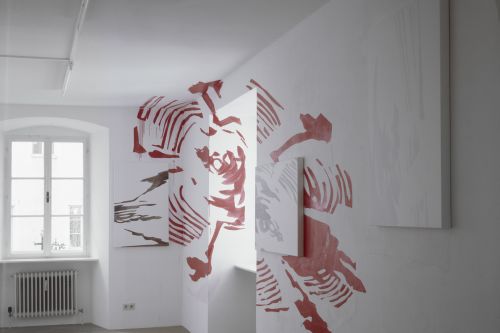Richard Artschwager (1923–2013). Selected solo exhibitions include Mart, Rovereto (2019, travelled to Guggenheim Museum, Bilbao), Nouveau musée national de Monaco (2014), Whitney Museum of American Art, New York (2012, travelled to Hammer Museum, Los Angeles; Haus der Kunst, Munich and Nouveau musée national de Monaco), Museum of Contemporary Art, Miami (2003), Kunstmuseum Winterthur (2003, travelled to Kaiser-Wilhelm-Museum, Krefeld and Staatliche Graphische Sammlung, Munich), Museum für angewandte Kunst, Vienna (2002), Neues Museum, Nurmberg (2001, travelled to Serpentine Gallery, London), Portikus, Frankfurt (1993, travelled to Lenbachhaus, Munich), San Francisco Museum of Modern Art (1988, travelled to Museum of Contemporary Art, Los Angeles; Palacio de Velásquez, Madrid; Centre Georges Pompidou, Paris and Städtische Kunsthalle, Dusseldorf). Group exhibitions include Kunstmuseum Wolfsburg (2019, 2014, 2009, 2008, 1999), Stedelijk Museum voor Aktuelle Kunst, Ghent (2018), Fischer Landau Center for Arts, New York (2017), Whitney Museum of American Art, New York (2015, 2010, 2009), Fondazione Prada, Venice (2014, 2013), Museo Jumex, Mexico City (2011), PS1 MoMA, New York, Museum of Contemporary Art, Los Angeles (both 2009), Museum of Modern Art, New York (2005), Smithsonian Museum, New York (2004) and Tate, London (1998).
| The Art Institute of Chicago |
| Berardo Museum-Collection of Modern and Contemporary Art, Lisbon |
| The Broad, Los Angeles |
| Castellani Art Museum, Lewiston |
| Chazen Museum of Art, Madison |
| The Corcoran Gallery of Art, Washington DC |
| Daimler Contemporary, Berlin |
| David Winton Bell Gallery, Providence, RI |
| The Detroit Institute of Arts, Detroit |
| Fogg Art Museum, Cambridge, MA |
| Fondation Cartier pour l'art contemporain, Paris |
| FRAC-Picardie, Amiens |
| FRAC-Bretagne, Châteaugiron |
| FRAC-Limousin, Limoges |
| FRAC-Rhône-Alpes, IAC-Institute d'art contemporain, Villeurbanne |
| Kunstmuseum Basel |
| Kunstmuseum Winterthur |
| Kunstmuseum Wolfsburg |
| L.A.C.-Lieu d'Art Contemporaine, Sigean |
| Los Angeles County Museum of Art |
| Mildred Lane Kemper Art Museum, Saint Louis, MO |
| Museum of Modern Art, New York |
| MuHKA Museum voor Hedendaagse Kunst Antwerpen |
| Museu d'Art Contemporani de Barcelona |
| Museum Ludwig, Cologne |
| Museu Serralves-Museu de Arte Contemporânea, Porto |
| Museum of Contemporary Art Chicago |
| Neue Galerie Graz am Landesmuseum Joanneum, Graz |
| Pomona College Museum of Art, Claremont, CA |
| Samek Art Gallery, Lewisburg, PA |
| San Francisco Museum of Modern Art |
| Schaulager, Münchenstein/Basel |
| SMAK Stedelijk Museum voor Actuele Kunst, Ghent |
| Tate Modern, London |
| Tate Britain, London |
| The West Collection, Oaks, PA |
| Vancouver Art Gallery, Vancouver |
| Whitney Museum of American Art, New York |





























































